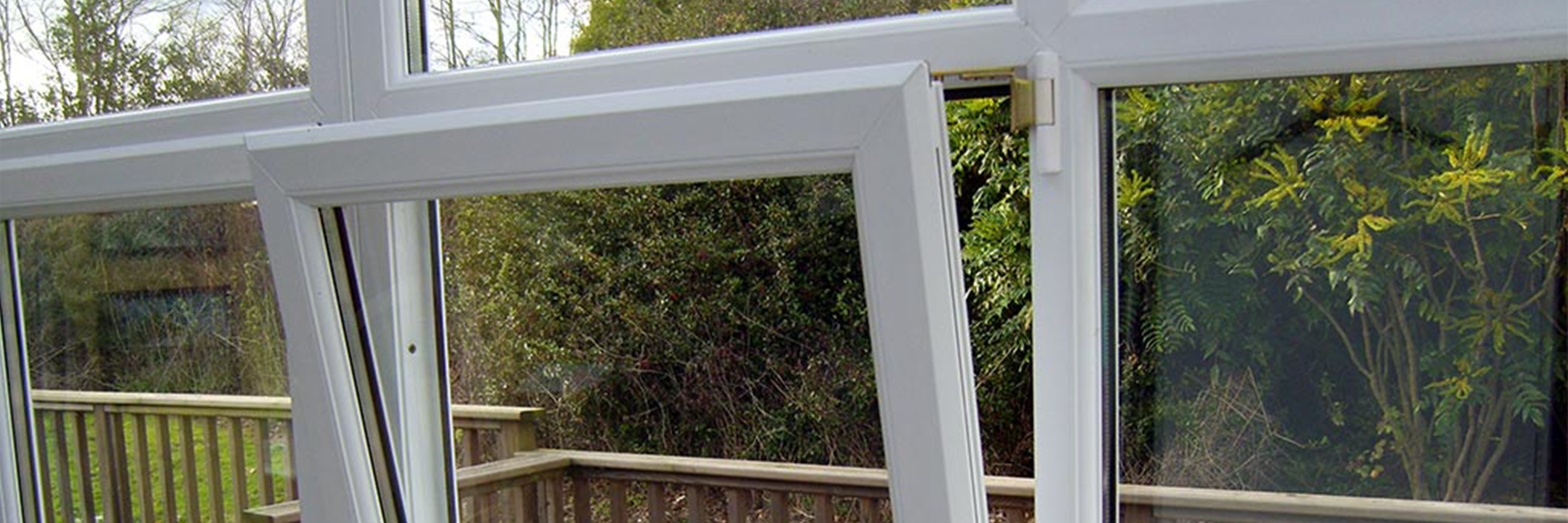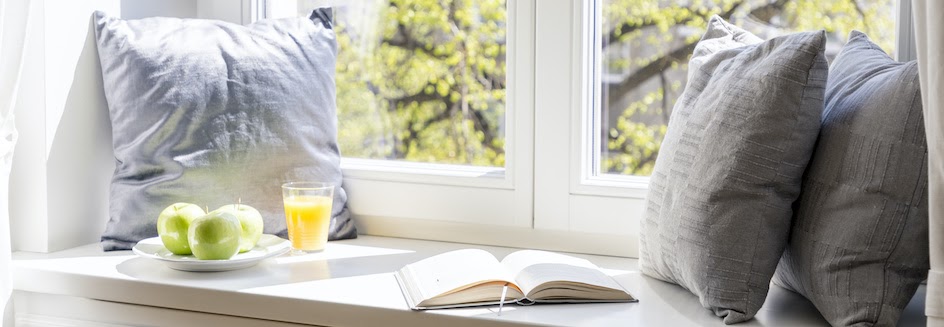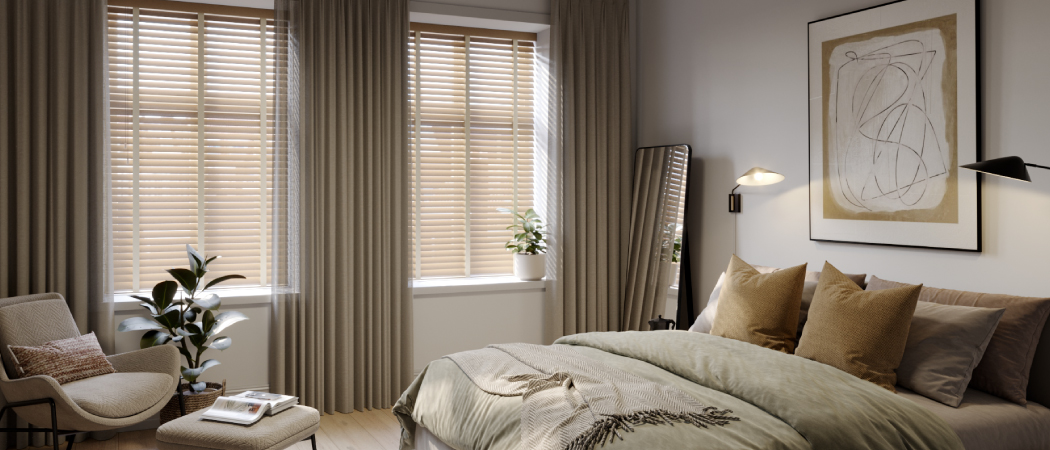Houses come with all sorts of windows, but one thing we’ve noticed recently is that a lot of new build homes have windows and doors that open on two hinges. On one side they open like a normal window, but they also feature a bottom hinge that allows the window pane to come into the room at an angle. When titled open, the top of the window leans inwards towards you. Technically these are called tilt and turn windows or casement windows, and they cause all sorts of problems when fitting window coverings.
While most blinds (and all curtains) are unsuitable for this style, we do have a range of blinds that are perfect for this tricky style. Here, we’ll show you the best blinds for tilt and turn windows. Plus, you’ll find installation tips to ensure your blinds don’t obstruct the dual functionality of your windows.
What Are Tilt and Turn Windows?
Tilt and turn windows are European-style windows where the window opens on two hinges. This enables movement both from a traditional side hinge as well as a bottom hinge that provides a top tilt function. Homeowners enjoy these windows thanks to their easy cleaning, low maintenance and durability.
As opposed to fixed window types, these windows offer better fresh air flow and can help when it comes to energy efficiency. These versatile window systems feature multi-point turn position handles that enable you to control how much air comes in and out of your home. Since these are energy efficient windows, they offer energy savings on cooling bills as you can use the breeze to maintain an ambient temperature throughout your home.
Mounting Considerations
There are two ways to mount window blinds: inside the recess and outside the recess. Inside the recess mounts are when the blinds are mounted directly inside the hollow of the window. The window dressings can be face fixed — mounted directly to the window frame that faces into the room — or top fixed. That’s where the blinds are mounted to the underside on the lintel — the structural support at the top of your window recess.
An outside the recess mount is when the blinds are mounted on the face of the wall just above the window opening. Inside the recess mounts are most common as they provide a sleek and seamless look. However, outside the recess mounts are useful for windows with narrow ledges and those that have obstructions such as large handles.
Window treatments installed within the recess of tilt turn windows can pose a bit of a problem as they may get in the way of the open window. This is especially noticeable with some of the bulkier wooden blinds like venetians. If your heart’s set on a traditional blind, leave as wide a gap as possible between the window and the blind, installing close to the edge of the recess to allow the window to tilt inwards. You can also try wooden plantation shutters instead which open fully into the room like tilt and turn windows.
However, for those with shallow recesses, even leaving a wide berth may not be an option. For those windows, mounting outside the recess is a better choice. Below we’ve listed some of the best ways to mount blinds for tilt and turn windows without losing the dual-opening functionality.
The Best Blinds for Tilt and Turn Windows
You don’t want your fly screens or blinds to affect the opening and closing of your tilt and turn windows. That’s why it’s important to choose the right styles. Perfect Fit blinds and conservatory blinds are among the best choices for these windows. That’s because these types of blinds snap directly into the beading of your UPVC window frame. That means you don’t have to use power tools or screws to mount them. Plus, you don’t have to move the blinds since they’re integrated into the doors or windows.
Bottom-up and top-down blinds are another good choice for tilt and turn windows because they are fully adjustable. These blinds are like honeycomb blinds and they operate on a chain mechanism. While traditional blinds only let you open or close from the top, these blinds can be adjusted from the bottom as well. You can pull the blind up from the bottom and down from the top, covering only the middle portion of the window. Alternatively, you can cover the entire bottom portion of the top half, depending on your preferences.
With top-down and bottom-up blinds, you can easily tilt your windows inwards without obstructing the movement. Just make sure to mount these blinds outside the recess or far enough away from the window so that it can tilt open fully.
In some cases, roller blinds and roman blinds may also be good choices. These are best when you’re mounting the blinds outside the recess as they feature a slim silhouette and styling details such as pleating that add texture and depth to the room.
How To Mount Blinds for Tilt and Turn Windows
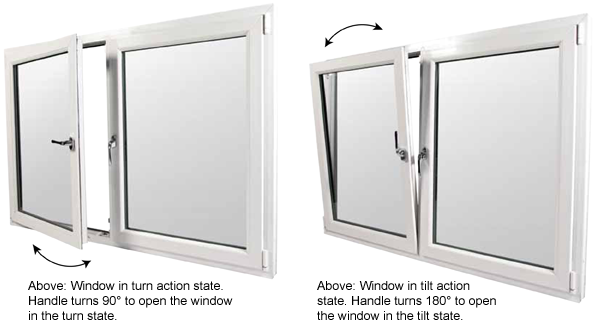
As mentioned, blinds for tilt and turn windows are best when mounted either outside the recess for narrow window ledges or inside the recess while maintaining as much distance from the window as possible. There are also various tilt and turn windows, with different hinges that may impact the functionality of blinds. Here, we’ve broken down the different tilt and turn window styles and the best way for you to mount blinds on them.
Windows That Only Tilt Inwards
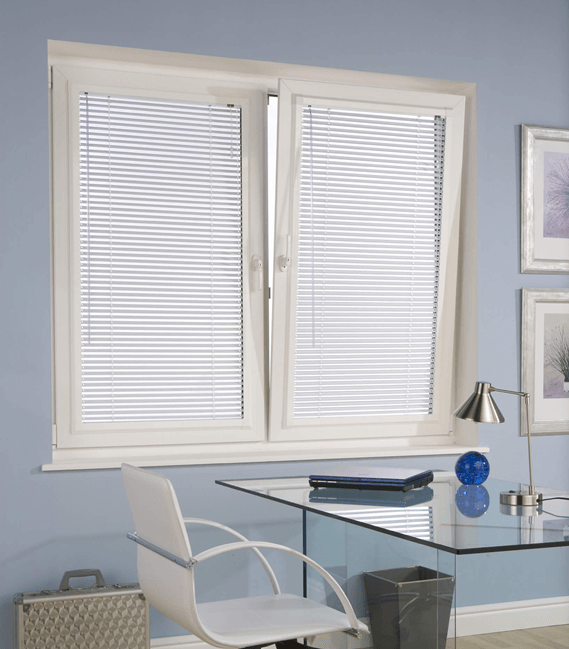
For windows with an inward tilt position, there are three options for coverage.
1. Install the blind outside of the window recess. This won’t be in the way of the window and will allow the window to open freely and unobstructed. Something like a roman blind — or an alternative pleated blind style — would work nicely here as it features layered fabrics that add a touch of elegance and style.
2. Choose Perfect Fit blinds or conservatory blinds that clip into the rubber beading between the single or double glazing and the frame of the window. This way you can still have your privacy, but also be able to open the window as required at the same time.
3. Install a blind with a shallow headrail inside the window recess, but right at the front so the blind is almost flush with the walls in your room. You’ll need to tilt the window and see how much room you are left to install in your recess. The depth of your window recess could limit your blind options when installing in this manner.
Windows That Tilt Inwards and Open Inwards on a Side Hinge
If your window can tilt inwards and open along a side hinge then there are a few things to think about. First, how often do you open the window fully using the side hinge? If the answer is not at all or very little, then you might be OK with one of the three options listed in the section above as your window is effectively used only as a tilting one.
However, if you regularly open the window on its side hinges then the best option would be to install it outside of the window recess. You’ll need to install it high enough to make sure that when the blind is fully pulled up, it clears the window reveal, allowing the window to fully open.
Wooden blinds and Venetian blinds won’t be suitable for this type of mount unless you want to raise and lower the blind every time you open the window inwards. That’s because these blinds have a large slat ‘stack’ height, so a blind of a 100cm drop, for example, would need to be mounted almost 20cm above the top of the window reveal to fully clear the window recess when pulled up — and this can look a bit silly.
Instead, roller blinds, roman blinds or blackout blinds will all be great choices. That’s because they have a slim profile when fully open.
Windows That Only Open Inwards on a Side Hinge
If your window only opens inwards on a side hinge, then you’ve got two options when it comes to mounting. Here are your choices.
1. Install the blind outside of the window recess. It should be mounted high enough so that when the blind is pulled up the blind clears the window reveal. That will allow the window to open inward freely.
2. Install a Perfect Fit blind or conservatory blind. Again, these clip onto the window itself, meaning they won’t obscure anything installed inside the recess, giving you the freedom to open your window whenever you like.
We don’t recommend installing something that could block and prevent an inward-opening window from being fully accessible, as sometimes these windows are designed to function as fire escapes. As such, we recommend sticking with the best blinds for tilt and turn windows: Perfect Fit blinds or conservatory blinds. In addition, it’s a good idea to mount outside the recess or to keep the blind as far away from the window frame as possible when mounting inside the recess.

